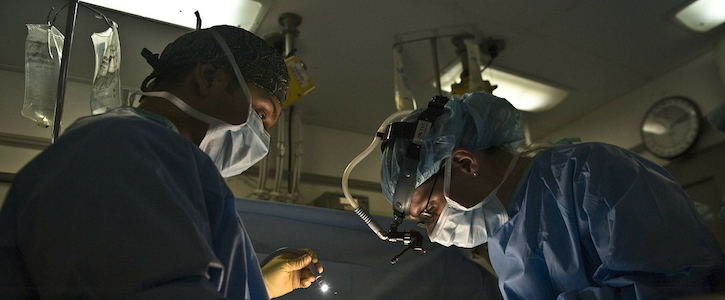Why Collecting Information in the OR Is Vital
Automated data collection can help health systems in more ways than one.

Many hospitals are facing trouble with low compliance rates of usage reporting inside the operating room, inaccurate charge capture, meeting FDA requirements regarding digital updates to the patient’s file and countless coding errors. These problems all have the potential to cause a financial loss.
Hospitals use advanced software solutions to improve processes, streamline workflow and optimize resources. By 2026, the healthcare information industry is forecasted to grow by 8.2%. Yet while these solutions specialize in data management and analyze procurement processes, they are not suited to the specific needs and work conditions in hospital operating rooms, resulting in deficient data collection. To be effective, they must answer the changing and exclusive needs of operating rooms, which differ greatly from other work areas.
Data integrity in the OR has enormous economic implications.
First and foremost, hospitals need the ability to know how much surgical procedures cost. Today, health systems rely on historical DRG repositories, but times have changed, and there is no reason to make economic forecasts based on old data.
An average hospital goes through about 5,000 implants and medical devices per month. Although hospitals strive to record each item individually, the level of reporting today is below 60% (PDF). Take items such as sewing thread or stampers. Although they are present in almost every procedure and can run up costs by $200 in some cases, they are not reported at all. In addition, items that cannot be tagged (such as sterile orthopedic implants, screws and plates) and bulk items often go unreported.
Then there’s the time spent on coding errors and the need to submit applications for reimbursement from insurance companies or Medicare programs (which often require applications within 72 hours), and you have a full-fledged recipe for inefficient cost retrieval. Today, there is a whole market of companies that offer this service at a fee, and hospitals share with them the money received from the insurance company and government programs.
Stop relay on medical teams.
Research claims that procurement software and hospitals’ information management systems designed for health systems actually slow down nurses’ work even more than manual documentation. Sometimes the reporting is even done manually in notebooks, causing human error, coding errors and lack of reporting. Those are the main reasons for the low compliance rate in the OR. Therefore, no matter how advanced the management software is, if it does not have the right tools to collect the information without involving the medical staff, it is not an appropriate solution that can achieve 100% reliability and integrity of data.
Incomplete information prevents an updated item master.
The first step in maintaining an updated item master begins with the use of the medical device. Providers typically need to report the item through scanning techniques. If the existing software does not identify the scanned item, other sources need to fill out the incomplete information.
Most hospitals receive medical implants according to the manufacturer’s SKU and then give the implants an internal catalog number. This SKU does not specify an expiration date, production series or other essential information about the item — because that would require too much work and the ability to read multiple manufacturer barcodes. Each manufacturer’s SKU often changes, items age and new suppliers are added. As a result, the maintenance of the item master becomes one of the hospital’s biggest problems, with financial and clinical implications.
Be patient-centric and full comply with FDA regulations.
Although the importance of data integrity and the synchronization of that information are essential, the consolidation of such information is not the norm.
Recalls occur, which require health systems and suppliers to locate all devices and patients using, say, implants. This is an impossible task when there is no complete listing of all items used and full documentation in the patient’s medical record. But a thorough process would be terribly time-consuming.
Medical Device Reporting (MDR) is the U.S. Food and Drug Administration’s regulatory tool for monitoring the performance of medical devices. When suspicion arises as to the safety of a product, healthcare organizations must provide critical information such as patient information, date, description of the case involving the medical device and brand information like product code, model number, serial number and expiration date.
Yet in reality, without the consolidation of clinical and logistical information and high documentation compliance by clinicians, hospitals can’t provide the above information despite their obligation to do so. This is one of the main factors driving hospitals to purchase information management software.
Using machine learning and artificial intelligence.
Most of today’s tools rely on technologies that have been adapted to work in the operating room but do not fully address the problems mentioned here. In other words, advanced software does not include advanced data collection in the field.
The first step is changing the perception in the OR — the human must no longer be part of data processing. The solution must be fully automated. Clinicians do not need to enter any information, and they are uninvolved in documentation and data management.
The good news is that the future is in many ways already here thanks to machine learning and artificial intelligence. These technologies are increasingly used in end devices inside the OR and procedurals room, collecting data in real time. Technologies such as image-processing tools, microphones and even sensors can collect, process and manage the information optimally.
Hospitals are already investing money in comprehensive data collection solutions to help complement their existing enterprise resource planning systems. Software companies, for their part, are also investing money in developing such solutions. This trend is expected to intensify as more hospitals recognize the benefits of automated data collection.
Shlomo Matityaho is CEO of LogiTag Medical Solutions.
Get the best insights in digital health directly to your inbox.
Dig Deeper
Reinventing Clinical Decision Support
Smart Shirt, Real-World Data Shine Light on Surgeon Stress
Who Is Responsible When AI Fails?